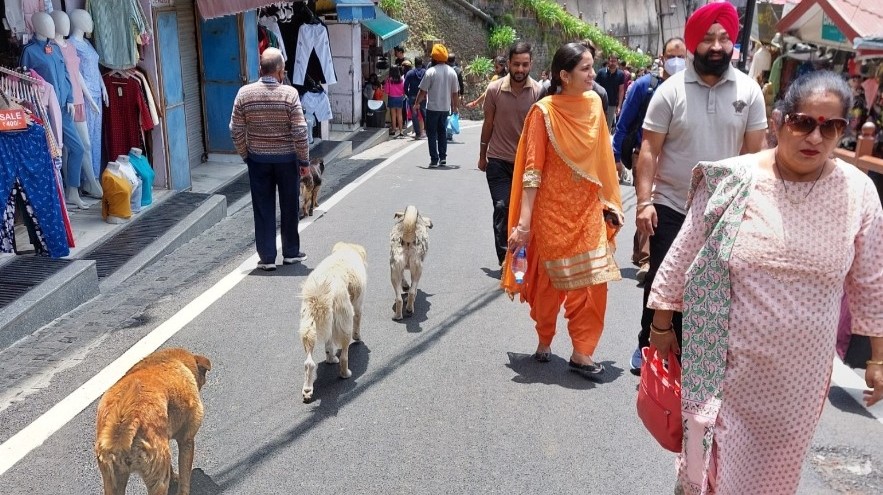India’s millions of stray dogs coexist largely peacefully with humans, however, an increase in dog attacks and the prevalence of rabies cases has sparked calls to introduce stronger policy to reduce their numbers. In this essay, Pupul Dutta Prasad applies insights from Tim Newburn and Andrew Ward‘s book, Orderly Britain: How Britain Has Resolved Everyday Problems, from Dog Fouling to Double Parking, to consider how India could reframe its approach to the street dog issue.
 In Orderly Britain, Professor of Criminology and Social Policy at LSE Tim Newburn (whose outstanding contribution to these fields has recently been celebrated) and journalist Andrew Ward succeed in foregrounding the ordinary, the mundane, and the marginal in service of a deeper purpose. The authors turn their gaze on dog fouling, smoking, drinking, queuing, using public toilets, and parking as a means of exploring changing social order in Britain. Rather than review the book (which has been done on this blog and elsewhere), I want to consider how the insights into dealing with everyday issues in Britain can be applied in other contexts, specifically, how Britain’s approach to dog fouling could be drawn upon to develop a better understanding of India’s problem with street dogs and some of the ways being publicly discussed to tackle it.
In Orderly Britain, Professor of Criminology and Social Policy at LSE Tim Newburn (whose outstanding contribution to these fields has recently been celebrated) and journalist Andrew Ward succeed in foregrounding the ordinary, the mundane, and the marginal in service of a deeper purpose. The authors turn their gaze on dog fouling, smoking, drinking, queuing, using public toilets, and parking as a means of exploring changing social order in Britain. Rather than review the book (which has been done on this blog and elsewhere), I want to consider how the insights into dealing with everyday issues in Britain can be applied in other contexts, specifically, how Britain’s approach to dog fouling could be drawn upon to develop a better understanding of India’s problem with street dogs and some of the ways being publicly discussed to tackle it.
The authors make two key observations in their analysis which are relevant when looking beyond Britain. First, they assert that meaningful enquiry into everyday social problems should involve taking a step back and looking at genealogy – how certain routines come to be viewed as problems in the first place. A key point the authors underline in this regard is that a thing does not get defined as a social problem without itself undergoing a social process. That process is often a site of contestation between contrasting perspectives or claims advanced by different groups with varying levels of influence.
[The authors] assert that meaningful enquiry into everyday social problems should involve taking a step back and looking at genealogy – how certain routines come to be viewed as problems in the first place.
Second, they take note of measures taken in response to a behaviour – previously tolerated – that begins to be thought of collectively as a social problem. Here, the authors draw our attention to formal mechanisms (laws, regulations, courts, etc.) as well as informal ones (social pressure and expectations). They observe that whereas the two frequently act in concert, in some respects it is often the less formal modes of control that have a greater impact.
Both the insights are substantiated, and indeed reinforced, by what the authors find to be the case with dog fouling. Their examination shows that in recent decades dog waste transformed from something that was once seen merely as unpleasant into a social problem requiring intervention. The presence of dog waste in public spaces has increasingly become perceived as a civic and moral failure, not just a public health risk. This has ensured that most dog owners in Britain now pick up and dispose of their dog’s faeces because they feel encouraged, via more informal means, to fulfil the social expectation placed on them. Fines and other penalties introduced for those that fail to “do the right thing” have of course played a part too.
At the outset, I ought to clear up that dog waste in public places does not get the attention in India which it does in Britain. This is not to pass any judgments on the comparative standards of public hygiene and individual conduct. Rather, the point of interest to me is that the lack of social concern for dog poo speaks precisely to the deeper sociological roots of problem-creation which Newburn and Ward highlight. Extrapolating that insight from their work, even though sections of the Indian citizenry presumably are troubled by dog fouling, in the collective mind of the society it is yet to be embedded as a problem.
Street dogs have long been an integral part of everyday life in India […] At the same time, they have adversely affected many lives as a source of rabies and other harm.
In contrast, the same is certainly not true of what is typically known as the “menace” or “terror” of street dogs. The term encompasses both those that have strayed from home or been abandoned and homeless, free-ranging dogs that have never had owners. Street dogs have long been an integral part of everyday life in India, with at least a handful of individuals in every community happy to feed them and have them around. At the same time, they have adversely affected many lives as a source of rabies and other harm. A public concern for health and safety and a consequent opposition to street dogs has recently been growing.
There are some notable factors behind the change in social attitudes towards street dogs. First is the sheer number of these dogs. One estimate puts their total population at roughly 59 million. In addition, the general perception is that the numbers are swelling all the time due to an ineffective regime for checking their overpopulation. Second, dog bites and attacks from free-roaming dogs, particularly afflicting children, are thought to be on the rise. With rabies cases and deaths in India being the highest worldwide, the danger such incidents pose to public health and safety has grown. Finally, the public anxiety over street dogs has been exacerbated by horrifying stories and videos on social and other media of children getting bitten and mauled by dogs, at times fatally.
In some instances the dogs involved in attacks are pets – “dangerous breeds” and “status dogs” like Pit Bulls, American Bulldogs, and Rottweilers – not the unsophisticated Indian pariah dogs on the street. Yet, this does not seem to cause as much outrage against the foreign species and their irresponsible, (mostly) rich owners. Implicit in this difference could be a power dynamic, a stronger hostility towards street dogs based on sheer numbers, or both. That said, a distinct social construction of the problem of street dogs in India is noticeable.
The contention is that the Animal Birth Control (ABC) Rules, 2023 (first introduced in 2001) take away the discretionary power local authorities had to remove, euthanise or kill stray dogs for keeping public spaces safe.
A growing demand for stringent measures to curb the menace of stray dogs is now evident. The focus of this demand is primarily on the control of their population. Some argue that the need for decisive action to achieve reduction in their population warrants a new legal option. The contention is that the Animal Birth Control (ABC) Rules, 2023 (first introduced in 2001) take away the discretionary power local authorities had to remove, euthanise or kill stray dogs for keeping public spaces safe. On this view, the ABC rules are effectively preventing the problem from being brought under control. The assumption behind it seems to be that street dog management through methods such as sterilisation and vaccination programmes, dog shelters, and garbage collection are either insufficient or have failed. A legal challenge to the ABC Rules is currently being heard by the Supreme Court of India.
Irrespective of what the judicial outcome is, there are grounds for scepticism that licence to exterminate street dogs will work, or be morally acceptable to the public. Even taking an instrumentalist point of view, experience shows that the existing statutory duty to sterilise and vaccinate street dogs has been neglected for reasons like lack of resources and lower prioritisation. This begs the question of how any new provision could be implemented. Moreover, the unbridled power sought to destroy street dogs raises animal rights and welfare issues including that of cruelty. Another dimension of the formal (lethal) means of addressing the problem is that it risks displacing the less formal (humane) ways, whose importance in shaping behavioural change comes out remarkably well in Newburn and Ward’s analysis.
A key – though often obscured – informal element in the Indian context is that humans and street dogs have become socialised to each other’s presence.
In my view, a key – though often obscured – informal element in the Indian context is that humans and street dogs have become socialised to each other’s presence. Both groups seem to have learned to go about their lives unperturbed by the other, making for proportionally low human-dog conflict, given the numbers in question. (See the pictures below of Shimla, the town where I live and work.)


In fact, one could make a valid argument for nurturing and consolidating this social bond between the two by explaining to people, especially school children, how to behave with street dogs. As environmentalist Ranjit Lal asserts, how a dog behaves depends a lot on how it has been treated. Others have also argued in favour of managing human conflicts with dogs by “putting double the effort in[to] educating the local community” about acting responsibly while feeding street dogs. Applying sociological insights from Newburn and Ward’s work enables a deeper and more nuanced understanding of India’s street dog problem. Clearly, there is a lot more to it than treating street dogs themselves as the problem and calling for a radical solution like culling.
Note: This essay gives the views of the author, and not the position of the LSE Review of Books blog, or of the London School of Economics and Political Science.
Image Credit: Pupul Dutta Prasad.







